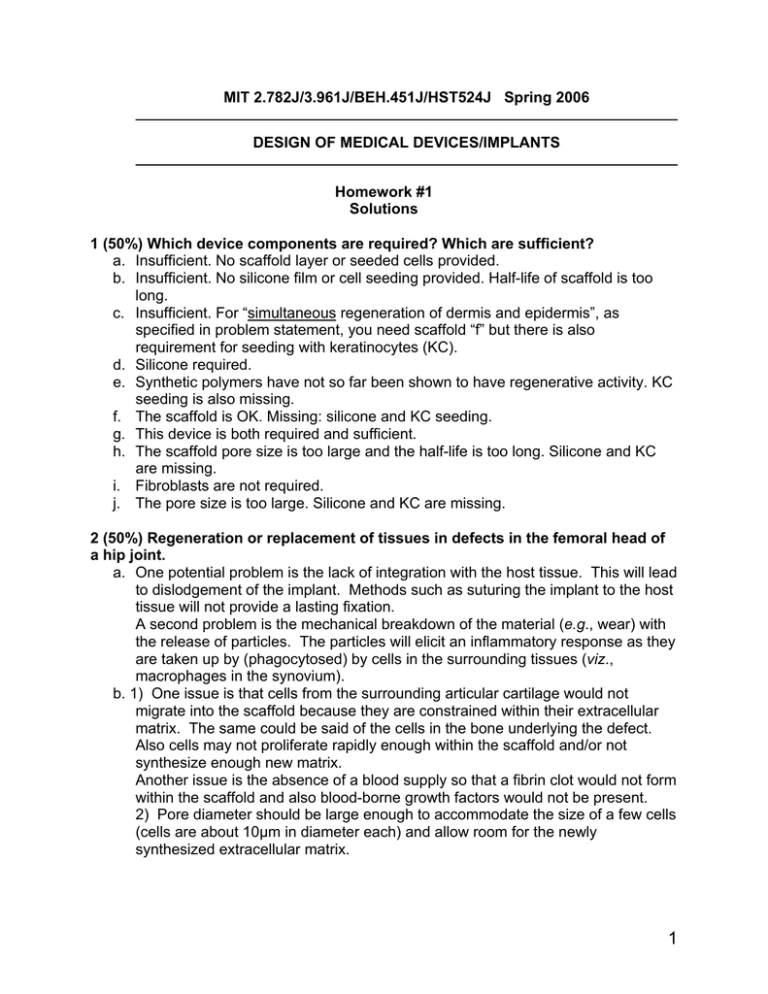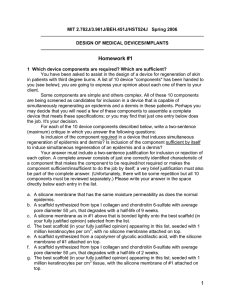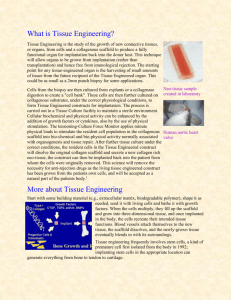MIT 2.782J/3.961J/BEH.451J/HST524J Spring 2006 DESIGN OF MEDICAL DEVICES/IMPLANTS Homework #1
advertisement

MIT 2.782J/3.961J/BEH.451J/HST524J Spring 2006 DESIGN OF MEDICAL DEVICES/IMPLANTS Homework #1 Solutions 1 (50%) Which device components are required? Which are sufficient? a. Insufficient. No scaffold layer or seeded cells provided. b. Insufficient. No silicone film or cell seeding provided. Half-life of scaffold is too long. c. Insufficient. For “simultaneous regeneration of dermis and epidermis”, as specified in problem statement, you need scaffold “f” but there is also requirement for seeding with keratinocytes (KC). d. Silicone required. e. Synthetic polymers have not so far been shown to have regenerative activity. KC seeding is also missing. f. The scaffold is OK. Missing: silicone and KC seeding. g. This device is both required and sufficient. h. The scaffold pore size is too large and the half-life is too long. Silicone and KC are missing. i. F ibroblasts are not required. j. The pore size is too large. Silicone and KC are missing. 2 (50%) Regeneration or replacement of tissues in defects in the femoral head of a hip joint. a. One potential problem is the lack of integration with the host tissue. This will lead to dislodgement of the implant. Methods such as suturing the implant to the host tissue will not provide a lasting fixation. A second problem is the mechanical breakdown of the material (e.g., wear) with the release of particles. The particles will elicit an inflammatory response as they are taken up by (phagocytosed) by cells in the surrounding tissues (viz., macrophages in the synovium). b. 1) One issue is that cells from the surrounding articular cartilage would not migrate into the scaffold because they are constrained within their extracellular matrix. The same could be said of the cells in the bone underlying the defect. Also cells may not proliferate rapidly enough within the scaffold and/or not synthesize enough new matrix. Another issue is the absence of a blood supply so that a fibrin clot would not form within the scaffold and also blood-borne growth factors would not be present. 2) Pore diameter should be large enough to accommodate the size of a few cells (cells are about 10µm in diameter each) and allow room for the newly synthesized extracellular matrix. 1 3) The surgeon could put holes into the underlying bone to allow bleeding into the defect to form a fibrin clot and to allow marrow-derived mesenchymal stem cells to infiltrate (migrate into) the clot. 4) Cells could be autologous (from the same patient) taken from a biopsy of cartilage (differentiated chondrocytes). The advantage is that the cells are already differentiated chondrocytes. The disadvantage is the donor site morbidity and that the donor tissue is not readily accessible. Cells could be allogeneic (from anther individual) taken from cartilage (differentiated chondrocytes). The advantages are that the cells are already differentiated chondrocytes and there is no donor site morbidity. The disadvantage is the potential for transmission of disease and immune response. Autologous marrow-derived stem cells could be used. The advantage is that they are more readily accessible than chondrocytes. The potential problem is that they may not differentiate into chondrocytes, and may differentiate into unwanted cell types. 5) An absorbable form of CAR would be best for this application. If a non­ absorbable form were to be used the presence of the material could adversely affect the mechanical behavior of the tissue and interfere with tissue formation. c. May be best to start with the porous absorbable forms of CAR and BON bonded to each other. Stem cells derived from bone marrow that infiltrate (migrate into) the pores of the BON material might differentiate into bone and the stem cells migrating into the CAR portion in the superficial region of the defect might form cartilage. If this does not work out, one might seed the CAR portion of the implant with autologous chondrocytes prior to implantation. 2








